Compression after Impact Behaviour and Failure Analysis of Nanosilica-Toughened Thin Epoxy/GFRP Composite Laminates
Abstract
:1. Introduction
2. Materials and Methods
2.1. Materials and Fabrication of Composite Laminates
2.2. Fourier-Transform Infrared (FTIR) Spectroscopy
2.3. Low-Velocity Drop Weight Impact Tests
2.4. Damage Assessment by Image Analysis
2.5. Compression after Impact (CAI) Tests
2.6. Failure Analysis Using SEM
3. Results
3.1. FTIR Spectroscopy Analysis
3.2. Responses of Low-Velocity Drop Weight Impact Tests
3.3. Assessment of Induced Damage Due to Low-Velocity Impact Experiments
3.4. Residual Compressive Strength of Low-Velocity Impacted Specimens
3.5. Fracture Analysis of Laminates by SEM
3.6. Key Toughening Mechanisms in Nanosilica-Reinforced GFRP Composite Laminates
4. Conclusions
- From FTIR spectrums it can be observed that the dispersion of nanosilica particles in epoxy resin did not change the characteristics of epoxy and its properties were retained. It also suggests that there was no chemical reaction between the nanosilica and epoxy and the bonding was just a physical process.
- Responses of low-velocity impact experiments disclosed that nanofiller-toughened composite laminates exhibited enhanced peak load, reduced impact duration, and enhanced energy absorption while suppressing the damage propagation. The use of silica nanofillers enhanced matrix-fibre bonding, enhanced load transfer, and fracture toughness. Toughened composite laminates with 0.75 wt% nanosilica content offered superior results.
- Post-impact compression responses assessed through CAI conveys the effects of nanofillers on the residual compressive strength of the laminates. Significant enhancement in peak load and residual compressive strength was observed in toughened laminates. Composite laminates toughened with 1 wt% silica nanoparticles offered the highest peak load and compressive strength. This was due to the enhanced damage suppression observed during low-velocity impact experiments.
- Failure analysis of damaged surfaces through SEM reported the presence of key toughening mechanisms like the generation of micro-cracks, crack deflection, enhanced fiber-matrix interface, and superior load transfer to primary reinforcements which was frequently noted in nanofiller-toughened polymer materials. This section is not mandatory but can be added to the manuscript if the discussion is unusually long or complex.
Supplementary Materials
Author Contributions
Funding
Conflicts of Interest
References
- Boominathan, R.; Arumugam, V.; Santulli, C.; Sidharth, A.A.P.; Sankar, R.A.; Sridhar, B. Acoustic emission characterization of the temperature effect on falling weight impact damage in carbon/epoxy laminates. Compos. Part B Eng. 2014, 56, 591–598. [Google Scholar] [CrossRef]
- Arumugam, V.; Saravanakumar, K.; Santulli, C. Damage characterization of stiffened glass-epoxy laminates under tensile loading with acoustic emission monitoring. Compos. Part B Eng. 2018, 147, 22–32. [Google Scholar] [CrossRef]
- Andrew, J.J.; Arumugam, V.; Saravanakumar, K.; Dhakal, H.; Santulli, C. Compression after impact strength of repaired GFRP composite laminates under repeated impact loading. Compos. Struct. 2015, 133, 911–920. [Google Scholar] [CrossRef]
- Kostopoulos, V.; Baltopoulos, A.; Karapappas, P.; Vavouliotis, A.; Paipetis, A. Impact and after-impact properties of carbon fibre reinforced composites enhanced with multi-wall carbon nanotubes. Compos. Sci. Technol. 2010, 70, 553–563. [Google Scholar] [CrossRef]
- Mercy, J.L.; Prakash, S.; Krishnamoorthy, A.; Ramesh, S.; Anand, D.A. Multi response optimisation of mechanical properties in self-healing glass fiber reinforced plastic using grey relational analysis. Measurement 2017, 110, 344–355. [Google Scholar] [CrossRef]
- Mercy, J.L.; Prakash, S.; Krishnamoorthy, A.; Ramesh, S.; Anand, D.A. Experimental investigation and multiresponse genetic optimization of drilling parameters for self-healing GFRP. J. Mech. Sci. Technol. 2017, 31, 3777–3785. [Google Scholar] [CrossRef]
- Davis, D.C.; Whalen, B.D. An experimental study of interlaminar shear fracture toughness of a nanotube reinforced composite. Compos. Part B Eng. 2011, 42, 105–116. [Google Scholar] [CrossRef]
- Sun, L.; Gibson, R.F.; Gordaninejad, F.; Suhr, J. Energy absorption capability of nanocomposites: A review. Compos. Sci. Technol. 2009, 69, 2392–2409. [Google Scholar] [CrossRef]
- Mokhireva, K.A.; Svistkov, A.L.; Solod’Ko, V.N.; Komar, L.A.; Stöckelhuber, K.W. Experimental analysis of the effect of carbon nanoparticles with different geometry on the appearance of anisotropy of mechanical properties in elastomeric composites. Polym. Test. 2017, 59, 46–54. [Google Scholar] [CrossRef]
- Karapappas, P.; Vavouliotis, A.; Tsotra, P.; Kostopoulos, V.; Paipetis, A. Enhanced Fracture Properties of Carbon Reinforced Composites by the Addition of Multi-Wall Carbon Nanotubes. J. Compos. Mater. 2009, 43, 977–985. [Google Scholar] [CrossRef]
- Saboori, B.; Ayatollahi, M.R. Experimental fracture study of MWCNT/epoxy nanocomposites under the combined out-of-plane shear and tensile loading. Polym. Test. 2017, 59, 193–202. [Google Scholar] [CrossRef]
- Elango, N.; Gupta, N.S.; Jiun, Y.L.; Golshahr, A. The Effect of High Loaded Multiwall Carbon Nanotubes in Natural Rubber and Their Nonlinear Material Constants. J. Nanomater. 2017, 2017, 1–15. [Google Scholar] [CrossRef] [Green Version]
- Tang, L.-C.; Wan, Y.-J.; Yan, D.; Pei, Y.-B.; Zhao, L.; Li, Y.-B.; Wu, L.-B.; Jiang, J.-X.; Lai, G.-Q. The effect of graphene dispersion on the mechanical properties of graphene/epoxy composites. Carbon 2013, 60, 16–27. [Google Scholar] [CrossRef]
- Al-Maharma, A.Y.; Sendur, P. The effect of inter-laminar graphene nano-sheets reinforced e-glass fiber/epoxy on low velocity impact response of a composite plate. Mater. Res. Express 2018, 5, 055021. [Google Scholar] [CrossRef]
- Zaman, I.; Phan, T.T.; Kuan, H.-C.; Meng, Q.; La, L.T.B.; Luong, L.; Youssf, O.; Ma, J. Epoxy/graphene platelets nanocomposites with two levels of interface strength. Polymer 2011, 52, 1603–1611. [Google Scholar] [CrossRef] [Green Version]
- Zappalorto, M.; Salviato, M.; Quaresimin, M. Mixed mode (I + II) fracture toughness of polymer nano-clay nano composites. Eng. Fract. Mech. 2013, 111, 50–64. [Google Scholar] [CrossRef]
- Guevara-Morales, A.; Taylor, A.C. Mechanical and dielectric properties of epoxy-clay nano composites. Mater. Sci. 2014, 49, 1574–1584. [Google Scholar] [CrossRef]
- Krushnamurty, K.; Srikanth, I.; Rangababu, B.; Majee, S.K.; Bauri, R.; Subrahmanyam, C. Effect of nano clay on the toughness of epoxy and mechanical, impact properties of E-glass-epoxy composites. Adv. Mater. Lett. 2015, 6, 684–689. [Google Scholar] [CrossRef]
- Gong, L.-X.; Hu, L.-L.; Zang, J.; Pei, Y.-B.; Zhao, L.; Tang, L.-C. Improved interfacial properties between glass fibers and tetra-functional epoxy resins modified with silica nanoparticles. Fibers Polym. 2015, 16, 2056–2065. [Google Scholar] [CrossRef]
- Fathy, A.; Shaker, A.; Hamid, M.A.; Megahed, A.A. The effects of nanosilica/nano-alumina on fatigue behavior of glass fiber-reinforced epoxy composites. J. Compos. Mater. 2017, 51, 1667–1679. [Google Scholar] [CrossRef]
- Johnsen, B.; Kinloch, A.; Mohammed, R.; Taylor, A.; Sprenger, S.; Kinloch, A. Toughening mechanisms of nanoparticle-modified epoxy polymers. Polymer 2007, 48, 530–541. [Google Scholar] [CrossRef]
- Fan, Z.; Santare, M.H.; Advani, S.G. Interlaminar shear strength of glass fiber reinforced epoxy composites enhanced with multi-walled carbon nanotubes. Compos. Part A Appl. Sci. Manuf. 2008, 39, 540–554. [Google Scholar] [CrossRef]
- Seyhan, A.T.; Tanoglu, M.; Schulte, K. Mode I and mode II fracture toughness of E-glass non-crimp fabric/carbon nanotube (CNT) modified polymer based composites. Eng. Fract. Mech. 2008, 75, 5151–5162. [Google Scholar] [CrossRef] [Green Version]
- Coleman, J.; Khan, U.; Gun’Ko, Y.K. Mechanical Reinforcement of Polymers Using Carbon Nanotubes. Adv. Mater. 2006, 18, 689–706. [Google Scholar] [CrossRef]
- Suresh, S.; Venkatesan, K.; Natarajan, E. Influence of SiC Nanoparticle Reinforcement on FSS Welded 6061-T6 Aluminum Alloy. J. Nanomater. 2018, 2018, 1–11. [Google Scholar] [CrossRef] [Green Version]
- Subramani, V.; Jayavel, B.; Sengottuvelu, R.; Lazar, P.J.L. Assessment of Microstructure and Mechanical Properties of Stir Zone Seam of Friction Stir Welded Magnesium AZ31B through Nano-SiC. Materials 2019, 12, 1044. [Google Scholar] [CrossRef] [PubMed]
- Garcia, C.; Trendafilova, I.; Zucchelli, A. The Effect of Polycaprolactone Nanofibers on the Dynamic and Impact Behavior of Glass Fibre Reinforced Polymer Composites. J. Compos. Sci. 2018, 2, 43. [Google Scholar] [CrossRef]
- Garcia, C.; Trendafilova, I.; Zucchelli, A.; Contreras, J. The effect of nylon nanofibers on the dynamic behaviour and the delamination resistance of GFRP composites. MATEC Web Conf. 2018, 148, 14001. [Google Scholar] [CrossRef] [Green Version]
- Caminero, M.; García-Moreno, I.; Rodriguez, G. Experimental study of the influence of thickness and ply-stacking sequence on the compression after impact strength of carbon fibre reinforced epoxy laminates. Polym. Test. 2018, 66, 360–370. [Google Scholar] [CrossRef]
- Caminero, M.A.; García-Moreno, I.; Rodríguez, G.P.; Chacón, J.M. Internal damage evaluation of composite structures using phased array ultrasonic technique: Impact damage assessment in CFRP and 3D printed reinforced composites. Compos. Part B Eng. 2018, 165, 131–142. [Google Scholar] [CrossRef]
- Lazar, P.J.L.; Sengottuvelu, R.; Natarajan, E. Assessments of Secondary Reinforcement of Epoxy Matrix-Glass Fibre Composite Laminates through Nanosilica (SiO2). Materials 2018, 11, 2186. [Google Scholar] [CrossRef] [PubMed]
- Lal, L.P.J.; Ramesh, S.; Natarajan, E. Study on the repeatability of manufacturing nano-silica (SiO2) reinforced composite laminates. IOP Conf. Ser. Mater. Sci. Eng. 2018, 346, 012083. [Google Scholar]
- Dos Reis, J.M.L. Displacement rate effect on the flexural properties of glass fiber reinforced polyurethane. Mater. Res. 2016, 19, 183–186. [Google Scholar] [CrossRef] [Green Version]
- Borowski, E.; Soliman, E.; Kandil, U.F.; Taha, M.R. Interlaminar Fracture Toughness of CFRP Laminates Incorporating Multi-Walled Carbon Nanotubes. Polymers 2015, 7, 1020–1045. [Google Scholar] [CrossRef] [Green Version]
- Reis, P.; Ferreira, J.; Zhang, Z.; Benameur, T.; Richardson, M. Impact strength of composites with nano-enhanced resin after fire exposure. Compos. Part B Eng. 2014, 56, 290–295. [Google Scholar] [CrossRef]
- Gauvin, F.; Cousin, P.; Robert, M. Improvement of the interphase between basalt fibers and vinylester by nano-reinforced post-sizing. Fibers Polym. 2015, 16, 434–442. [Google Scholar] [CrossRef]
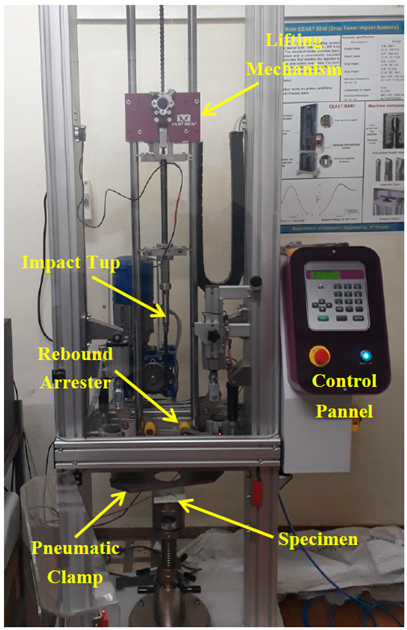

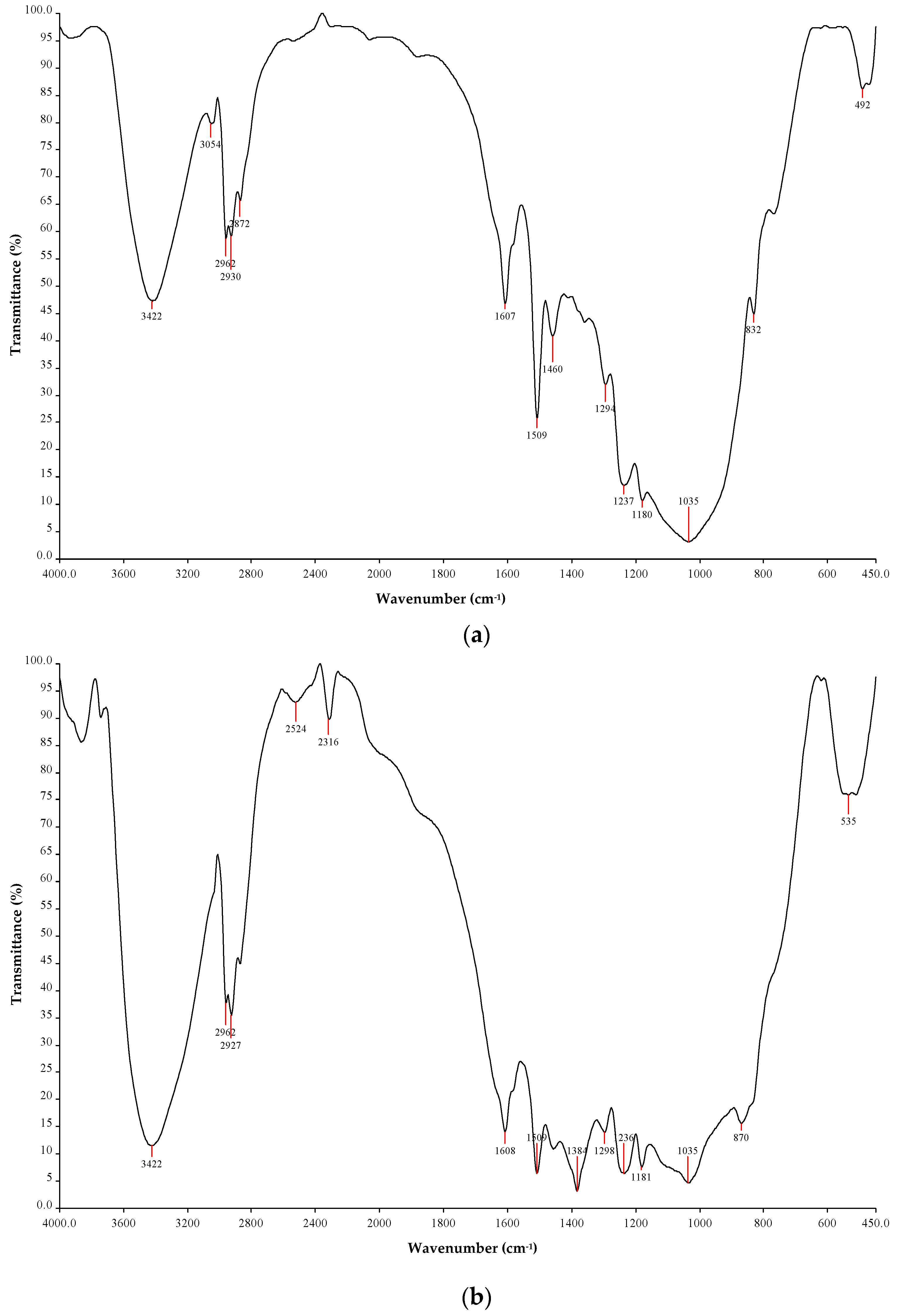
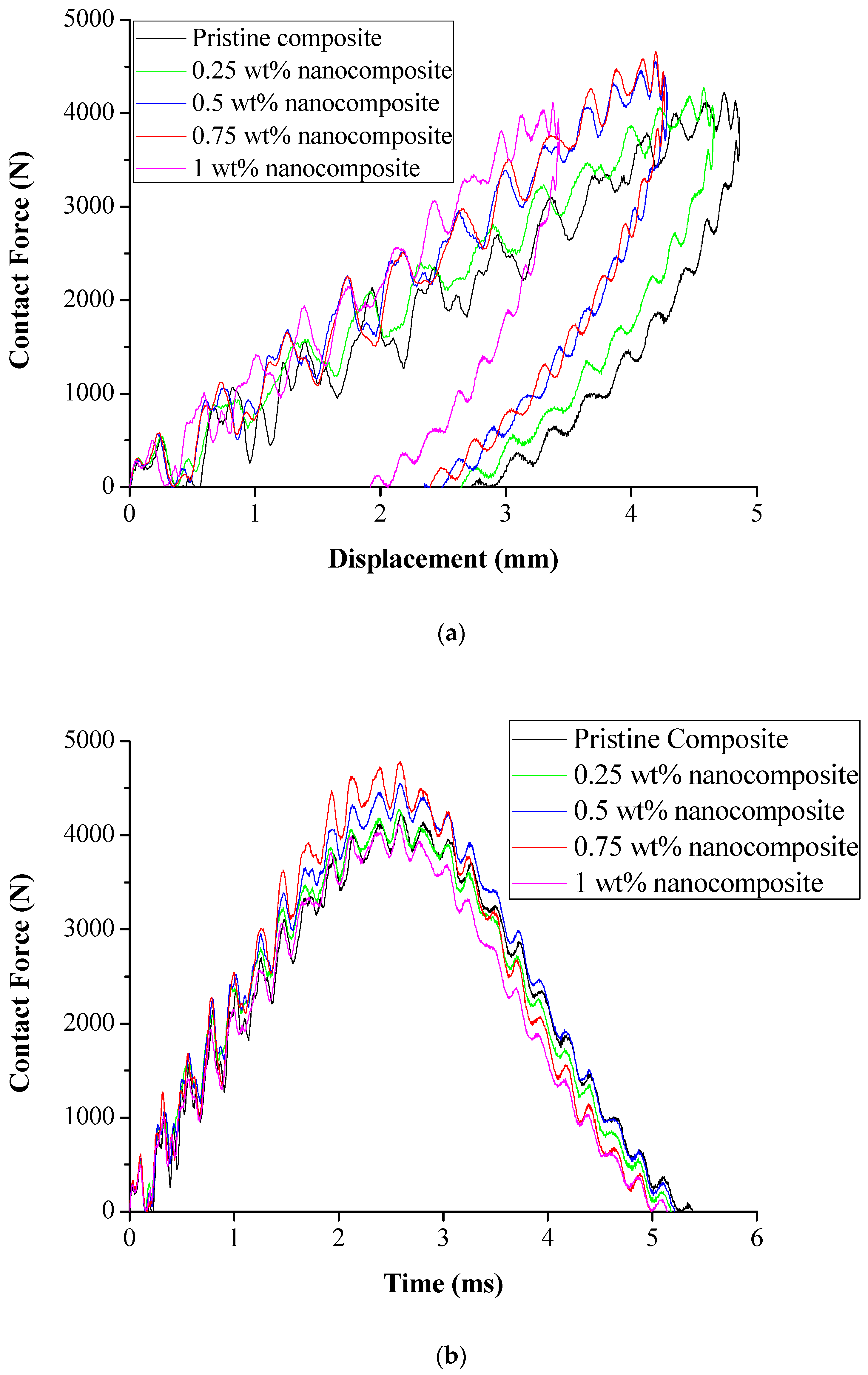

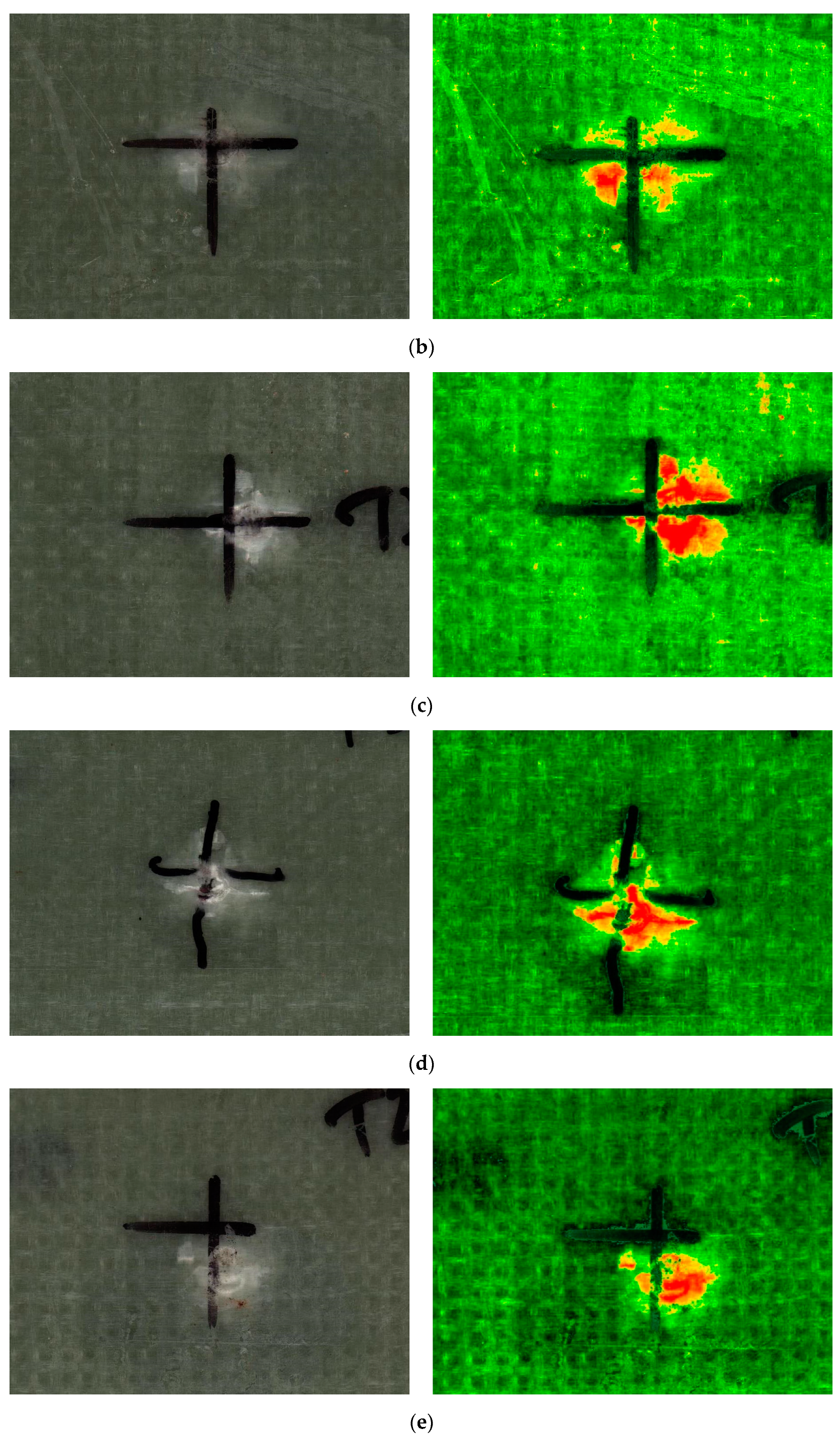




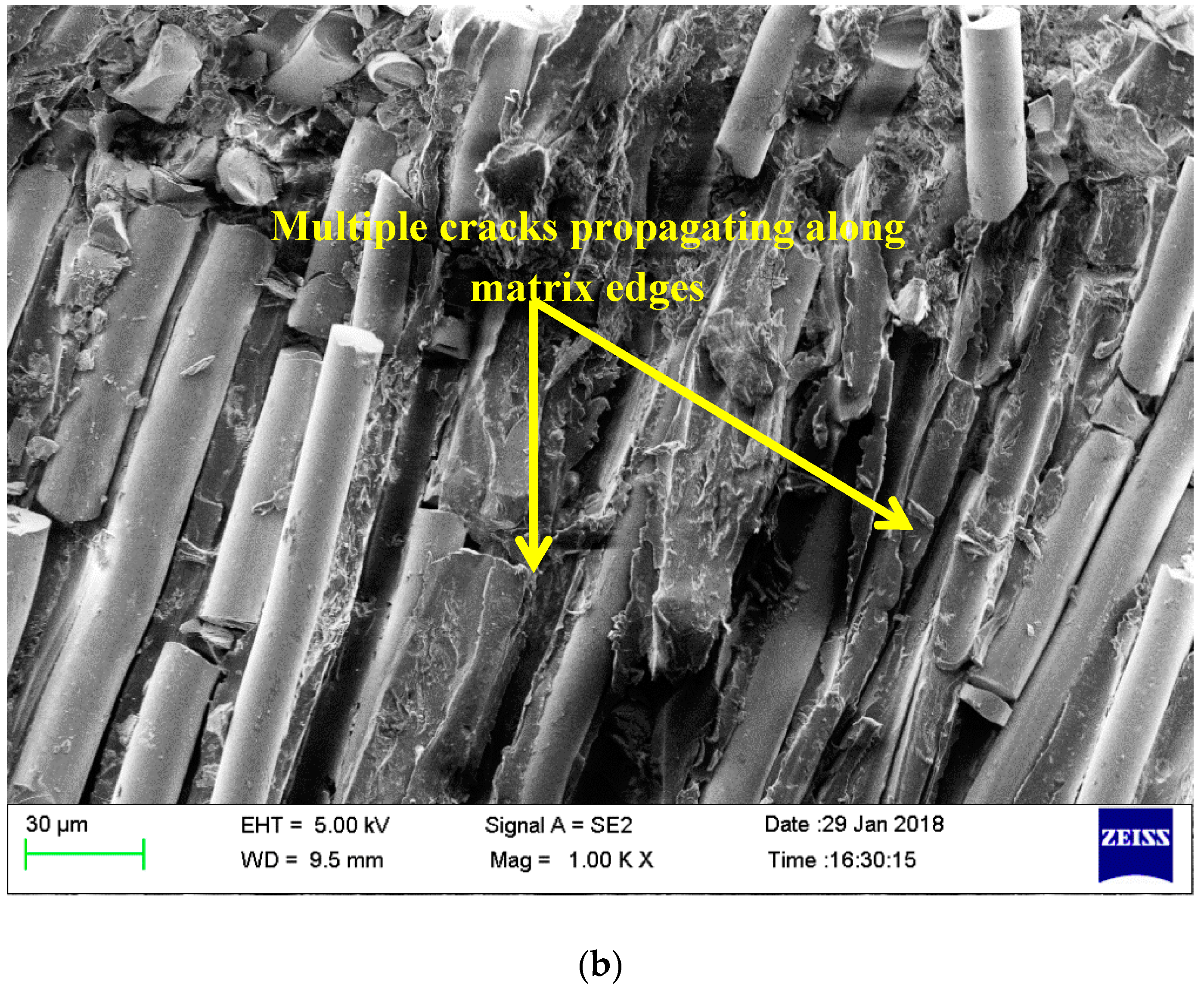
| Responses of Low-Velocity Impact | |||||
|---|---|---|---|---|---|
| Nanosilica Content (wt%) | Peak Contact Force (N) | Absorbed Energy (J) | Damage Area (mm2) | Peak Compression Load (N) | Compression Strength (MPa) |
| 0 | 4226 | 7.11 | 369 | 10,600 | 378.57 |
| 0.25 | 4275 | 7.13 | 275 | 14,700 | 525.2 |
| 0.5 | 4552 | 7.66 | 239 | 16,100 | 575.4 |
| 0.75 | 4582 | 7.74 | 175 | 20,300 | 725.3 |
| 1 | 4116 | 6.53 | 145 | 28,600 | 1021.8 |
© 2019 by the authors. Licensee MDPI, Basel, Switzerland. This article is an open access article distributed under the terms and conditions of the Creative Commons Attribution (CC BY) license (http://creativecommons.org/licenses/by/4.0/).
Share and Cite
Lal, L.P.J.; Ramesh, S.; Parasuraman, S.; Natarajan, E.; Elamvazuthi, I. Compression after Impact Behaviour and Failure Analysis of Nanosilica-Toughened Thin Epoxy/GFRP Composite Laminates. Materials 2019, 12, 3057. https://doi.org/10.3390/ma12193057
Lal LPJ, Ramesh S, Parasuraman S, Natarajan E, Elamvazuthi I. Compression after Impact Behaviour and Failure Analysis of Nanosilica-Toughened Thin Epoxy/GFRP Composite Laminates. Materials. 2019; 12(19):3057. https://doi.org/10.3390/ma12193057
Chicago/Turabian StyleLal, L. Prince Jeya, S. Ramesh, S. Parasuraman, Elango Natarajan, and I. Elamvazuthi. 2019. "Compression after Impact Behaviour and Failure Analysis of Nanosilica-Toughened Thin Epoxy/GFRP Composite Laminates" Materials 12, no. 19: 3057. https://doi.org/10.3390/ma12193057







